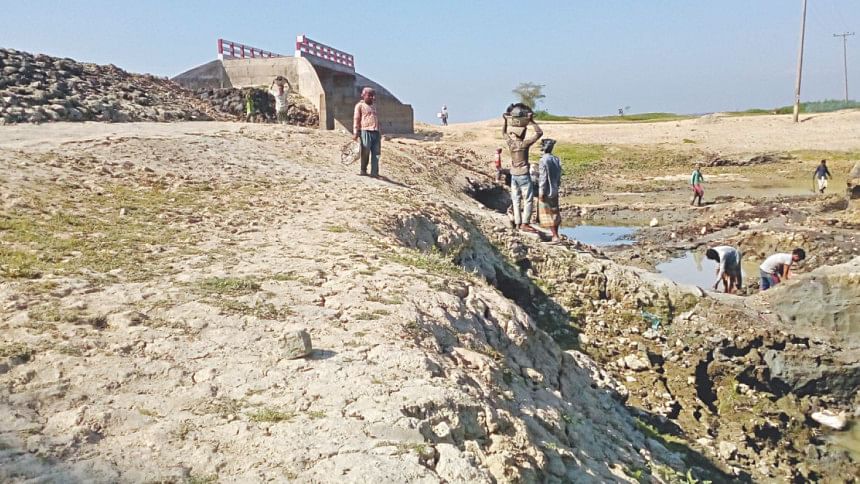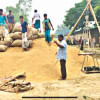Embankment woes in haor

When it comes to Boro paddy, Sunamganj usually offers a lion's share of the nationwide harvest. But for the last two years the district has suffered from flash floods, with the 2017 crop in Sunamganj and other haor wetland areas of the northeast all but wiped out. In response, the government initiated investment in embankment construction and repair. But with works originally scheduled for completion by February 28 still underway and in terms of construction quality, farmers are worried.
“We hope the embankment works in our area will be finished soon,” says one farmer, Fotik Miah from Kaliarkapon village in Dirai upazila. “We also have doubts about how long the embankments will last.”
Fotik believes there were anomalies in the forming of the project implementation committees which has resulted in low quality construction. “Soil has been taken from directly below the embankments. The embankments have not been compacted. It is uncertain how well they will withstand floods,” he says.
Government rules stipulate that no soil should be excavated from within 50 metres of an embankment under construction. After construction the earth of each embankment is supposed to be compacted and planted with grass.
The Daily Star recently visited three sites alongside Cheftir Haor in Dirai where workers were observed sourcing earth from as close as 10 metres, in violation of the rules.
Local farmers said most embankments are being constructed in such fashion.
The workers say it hasn't been possible to transport dirt from further afield because they can't excavate it from farmland and because the water levels in the haors took time to reduce, such that the soil in many areas was too wet to be of use.
“Anomalies are rife,” says Kasmir Reza, president of community group Paribesh O Haor Unnayan Sangstha. “Rules are being ignored. Progress is slack. Are our haor communities to be devastated once again this year?”
He estimates that more than 90 percent of the scheduled work is not yet complete and that only 65 percent of construction has reached a position where it can offer any protection at all.
This year, 987 works were slated for implementation by the same number of project implementation committees, at a current budget of Tk 112 crores. Of particular importance are 127 high-risk sites on 37 haors where breaches by flash floods have the potential to inundate vast areas.
To date work at five high-risk sites remains unfinished due to high water levels, with interim measures such as soil sacks having been implemented instead. Farmers fear that if these key sites are not adequately protected once the rain starts, the embankment work in many areas will have been in vain.
In response to findings that anomalies, negligence and corruption contributed to last year's catastrophe, new rules have also been implemented mandating the appointment of the local upazila nirbahi officer as president of each committee, a water development board official as secretary and the inclusion key local stakeholders as committee members. Work on all projects was supposed to start no later than December 15 and conclude by February 28.
On 6 March however, the water resources ministry extended the completion deadline to 15 March, but as the revised deadline also passes by much work remains.
“Progress is satisfactory,” says the water development board's executive engineer Md Abu Bakar Siddiq Bhuiya. “We hope all works will be completed long before there is any chance of flooding.”
According to the board, as at February 28 rates across Sunamganj for embankment work already completed ranged from 50 percent in Chhatak and Dirai upazilas to 80 percent in Sunamganj sadar upazila.
“We are considering all possible shortfalls and we will not spare anyone who doesn't complete haor embankment works properly and in time,” says Md Sabirul Islam, the deputy commissioner in Sunamganj.

 For all latest news, follow The Daily Star's Google News channel.
For all latest news, follow The Daily Star's Google News channel. 








Comments